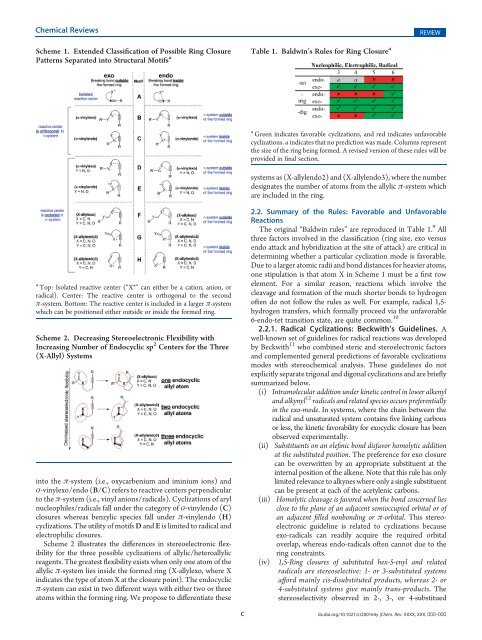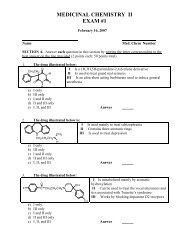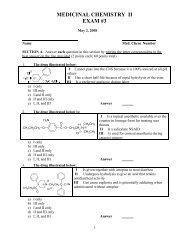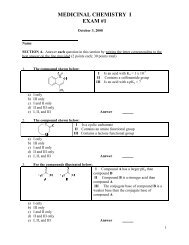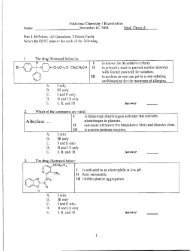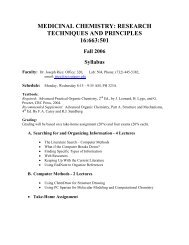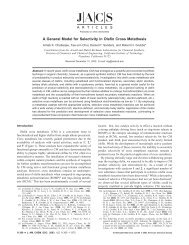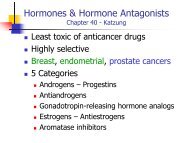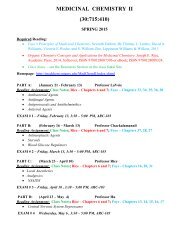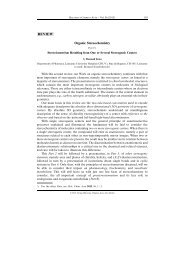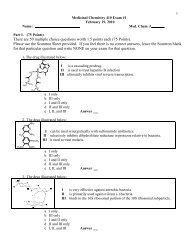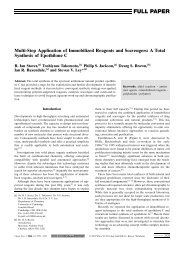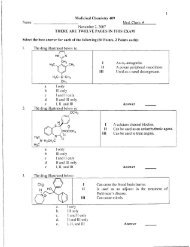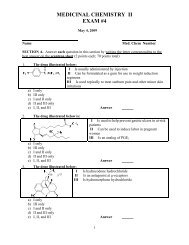Baldwin's Rules - Department of Medicinal Chemistry
Baldwin's Rules - Department of Medicinal Chemistry
Baldwin's Rules - Department of Medicinal Chemistry
You also want an ePaper? Increase the reach of your titles
YUMPU automatically turns print PDFs into web optimized ePapers that Google loves.
Chemical Reviews REVIEW<br />
Scheme 1. Extended Classification <strong>of</strong> Possible Ring Closure<br />
Patterns Separated into Structural Motifs a<br />
a Top: Isolated reactive center (“X*” can either be a cation, anion, or<br />
radical). Center: The reactive center is orthogonal to the second<br />
π-system. Bottom: The reactive center is included in a larger π-system<br />
which can be positioned either outside or inside the formed ring.<br />
Scheme 2. Decreasing Stereoelectronic Flexibility with<br />
Increasing Number <strong>of</strong> Endocyclic sp 2 Centers for the Three<br />
(X-Allyl) Systems<br />
into the π-system (i.e., oxycarbenium and iminium ions) and<br />
σ-vinylexo/endo (B/C) refers to reactive centers perpendicular<br />
to the π-system (i.e., vinyl anions/radicals). Cyclizations <strong>of</strong> aryl<br />
nucleophiles/radicals fall under the category <strong>of</strong> σ-vinylendo (C)<br />
closures whereas benzylic species fall under π-vinylendo (H)<br />
cyclizations. The utility <strong>of</strong> motifs D and E is limited to radical and<br />
electrophilic closures.<br />
Scheme 2 illustrates the differences in stereoelectronic flexibility<br />
for the three possible cyclizations <strong>of</strong> allylic/heteroallylic<br />
reagents. The greatest flexibility exists when only one atom <strong>of</strong> the<br />
allylic π-system lies inside the formed ring (X-allylexo, where X<br />
indicates the type <strong>of</strong> atom X at the closure point). The endocyclic<br />
π-system can exist in two different ways with either two or three<br />
atoms within the forming ring. We propose to differentiate these<br />
Table 1. Baldwin’s <strong>Rules</strong> for Ring Closure a<br />
a Green indicates favorable cyclizations, and red indicates unfavorable<br />
cyclizations. a indicates that no prediction was made. Columns represent<br />
the size <strong>of</strong> the ring being formed. A revised version <strong>of</strong> these rules will be<br />
provided in final section.<br />
systems as (X-allylendo2) and (X-allylendo3), where the number<br />
designates the number <strong>of</strong> atoms from the allylic π-system which<br />
are included in the ring.<br />
2.2. Summary <strong>of</strong> the <strong>Rules</strong>: Favorable and Unfavorable<br />
Reactions<br />
The original “Baldwin rules” are reproduced in Table 1. 9 All<br />
three factors involved in the classification (ring size, exo versus<br />
endo attack and hybridization at the site <strong>of</strong> attack) are critical in<br />
determining whether a particular cyclization mode is favorable.<br />
Due to a larger atomic radii and bond distances for heavier atoms,<br />
one stipulation is that atom X in Scheme 1 must be a first row<br />
element. For a similar reason, reactions which involve the<br />
cleavage and formation <strong>of</strong> the much shorter bonds to hydrogen<br />
<strong>of</strong>ten do not follow the rules as well. For example, radical 1,5hydrogen<br />
transfers, which formally proceed via the unfavorable<br />
6-endo-tet transition state, are quite common. 10<br />
2.2.1. Radical Cyclizations: Beckwith’s Guidelines. A<br />
well-known set <strong>of</strong> guidelines for radical reactions was developed<br />
by Beckwith 11 who combined steric and steroelectronic factors<br />
and complemented general predictions <strong>of</strong> favorable cyclizations<br />
modes with stereochemical analysis. These guidelines do not<br />
explicitly separate trigonal and digonal cyclizations and are briefly<br />
summarized below.<br />
(i) Intramolecular addition under kinetic control in lower alkenyl<br />
and alkynyl 12 radicals and related species occurs preferentially<br />
in the exo-mode. In systems, where the chain between the<br />
radical and unsaturated system contains five linking carbons<br />
or less, the kinetic favorability for exocyclic closure has been<br />
observed experimentally.<br />
(ii) Substituents on an olefinic bond disfavor homolytic addition<br />
at the substituted position. The preference for exo closure<br />
can be overwritten by an appropriate substituent at the<br />
internal position <strong>of</strong> the alkene. Note that this rule has only<br />
limited relevance to alkynes where only a single substituent<br />
can be present at each <strong>of</strong> the acetylenic carbons.<br />
(iii) Homolytic cleavage is favored when the bond concerned lies<br />
close to the plane <strong>of</strong> an adjacent semioccupied orbital or <strong>of</strong><br />
an adjacent filled nonbonding or π-orbital. This stereoelectronic<br />
guideline is related to cyclizations because<br />
exo-radicals can readily acquire the required orbital<br />
overlap, whereas endo-radicals <strong>of</strong>ten cannot due to the<br />
ring constraints.<br />
(iv) 1,5-Ring closures <strong>of</strong> substituted hex-5-enyl and related<br />
radicals are stereoselective: 1- or 3-substituted systems<br />
afford mainly cis-disubstituted products, whereas 2- or<br />
4-substituted systems give mainly trans-products. The<br />
stereoselectivity observed in 2-, 3-, or 4-substitued<br />
C dx.doi.org/10.1021/cr200164y |Chem. Rev. XXXX, XXX, 000–000


